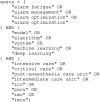Computational approaches to alleviate alarm fatigue in intensive care medicine: A systematic literature review
- PMID: 36052315
- PMCID: PMC9424650
- DOI: 10.3389/fdgth.2022.843747
Computational approaches to alleviate alarm fatigue in intensive care medicine: A systematic literature review
Abstract
Patient monitoring technology has been used to guide therapy and alert staff when a vital sign leaves a predefined range in the intensive care unit (ICU) for decades. However, large amounts of technically false or clinically irrelevant alarms provoke alarm fatigue in staff leading to desensitisation towards critical alarms. With this systematic review, we are following the Preferred Reporting Items for Systematic Reviews (PRISMA) checklist in order to summarise scientific efforts that aimed to develop IT systems to reduce alarm fatigue in ICUs. 69 peer-reviewed publications were included. The majority of publications targeted the avoidance of technically false alarms, while the remainder focused on prediction of patient deterioration or alarm presentation. The investigated alarm types were mostly associated with heart rate or arrhythmia, followed by arterial blood pressure, oxygen saturation, and respiratory rate. Most publications focused on the development of software solutions, some on wearables, smartphones, or headmounted displays for delivering alarms to staff. The most commonly used statistical models were tree-based. In conclusion, we found strong evidence that alarm fatigue can be alleviated by IT-based solutions. However, future efforts should focus more on the avoidance of clinically non-actionable alarms which could be accelerated by improving the data availability. Systematic Review Registration: https://www.crd.york.ac.uk/prospero/display_record.php?ID=CRD42021233461, identifier: CRD42021233461.
Keywords: Alarm fatigue; ICU; IT system; alarm management; alarm optimisation; critical care; intensive care unit; patient monitoring.
© 2022 Chromik, Klopfenstein, Pfitzner, Sinno, Arnrich, Balzer and Poncette.
Conflict of interest statement
The authors declare that the research was conducted in the absence of any commercial or financial relationships that could be construed as a potential conflict of interest.
Figures





References
Publication types
LinkOut - more resources
Full Text Sources

